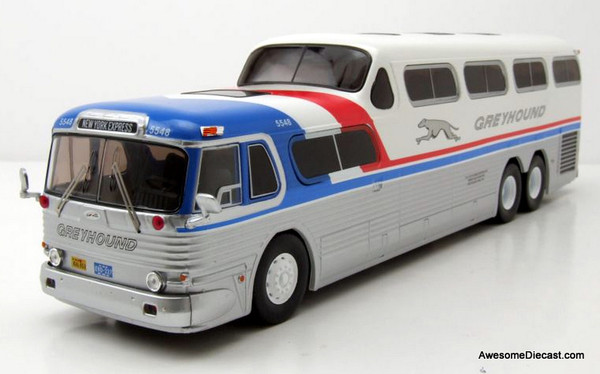IXO Models
IXO 1:43 GMC PD-4501 Scenicruiser GPX / Package Express: Greyhound Lines

IXO 1:43 GMC PD-4501 Scenicruiser GPX / Package Express: Greyhound Lines
$136.20
This bus features a rear portion that was converted to cargo carrying capabilities - removing the last 6 rows of seats.
The GMC PD-4501 Scenicruiser, manufactured by General Motors for The Greyhound Corporation, was a three-axle monocoque two-level coach used by Greyhound from July 1954 into the mid-70's. 1,001 were made between 1954 and 1956.
The Scenicruiser became an icon of the American way of life due to its presence throughout the USA in cities and along highways and popularity with the traveling public. The name was a portmanteau of the words "scenic" and "cruiser".
The high-level design concept of Scenicruiser resembles some of the rolling stock of the passenger-carrying railroads of the United States and Canada, particularly their popular stainless steel dome cars. This type of two-level motorcoach body was common in the late forties in Western Europe, including Great Britain where it was known as Observation coach.
The concept of two-level monocoque body had been used earlier in the Spanish Pegaso Z-403 two-axle coach, designed in 1949 and entered production in 1951.
The Model PD-4501 as GMC called it was the most distinctive American parlor bus design of the modern era. It was the result of seven years of effort by Greyhound and GM Truck and Coach Division. The first GX1 prototype was based on a design by Raymond Loewy as U.S. Patent 2,563,917. Originally conceived as a 35-foot (10.67 m) bus, Greyhound later used a tandem-axle 40-foot (12.19 m) prototype by Loewy called the GX-2 to lobby for the lifting of length restrictions of buses longer than 35 feet in most states at the time.
Power for the production models was originally provided by a pair of GM Diesel 4-71 four cylinder engines of 160 HP each connected by a fluid coupling. Two engines were necessary because GM had never seen the need for a V8 version of its Series 71 diesel engine. Each coach had a single three-speed transmission with a manual two-speed clutch for six forward speeds. There were some problems when the coaches were new because all of Greyhound's other models had four-speed manual transmissions that shifted differently than those in the Scenicruiser. This meant additional training for drivers, who mostly disliked the new system. This installation proved to be less than successful, and the 979 buses remaining in 1961-62 were rebuilt with 8V-71 engines and four-speed manual Spicer transmissions by the Marmon-Herrington Company.
The first design prototype for the Scenicruiser, the GX1, was a double decker with access from the lower deck and the driver seated on the upper deck. It was soon decided that a split-level design would be better because the GX1 was too tall for many Greyhound garages and lacked luggage space for 50 people. The GX-2 had a lower level containing the driver's area and entrance with ten seats plus a restroom on the passenger's side and an upper level with 33 more seats. This arrangement also allowed a large baggage compartment underneath the second level. This design was called the GX-2. Both the GX1 and GX-2 were actually built by Greyhound from 1947 to 1949 with help from GMC. In late 1951, GMC started work on its first prototype, called the EXP 331. It was completed in 1954 and had some unique features that were not used on the production versions. After the last PD 4501 prototype was built, it was rebuilt as a production model with serial number PD 4501-1001. The Scenicruiser was equipped with air-ride suspension and air conditioning. The coaches were unusual in having ten wheels. Each of the two rear axles had four wheels but only the forward axle was powered.
The Scenicruiser's popularity with the public inspired GM's later PD 4107 and PD 4903 Buffalo bus 35- and 40-foot models, which arrived nearly a decade later. They had a less obvious "second level" which ran most of the length of the coach, side windows from GMC's line of transit coaches and a smaller upper windshield in the front because the driver and first passenger seats were positioned higher. Unlike the Scenicruiser, these models were available for sale to all operators.
Greyhound Lines, Inc., usually shortened to Greyhound, is an intercity bus common carrier serving over 3,800 destinations across North America. The company's first route began in Hibbing, Minnesota in 1914, and the company adopted the Greyhound name in 1929. Since October 2007, Greyhound has been a subsidiary of British transportation company FirstGroup, but continues to be based in Dallas, Texas, where it has been headquartered since 1987. Greyhound and its sister companies in FirstGroup America are the largest motorcoach operators in the United States and Canada.


















